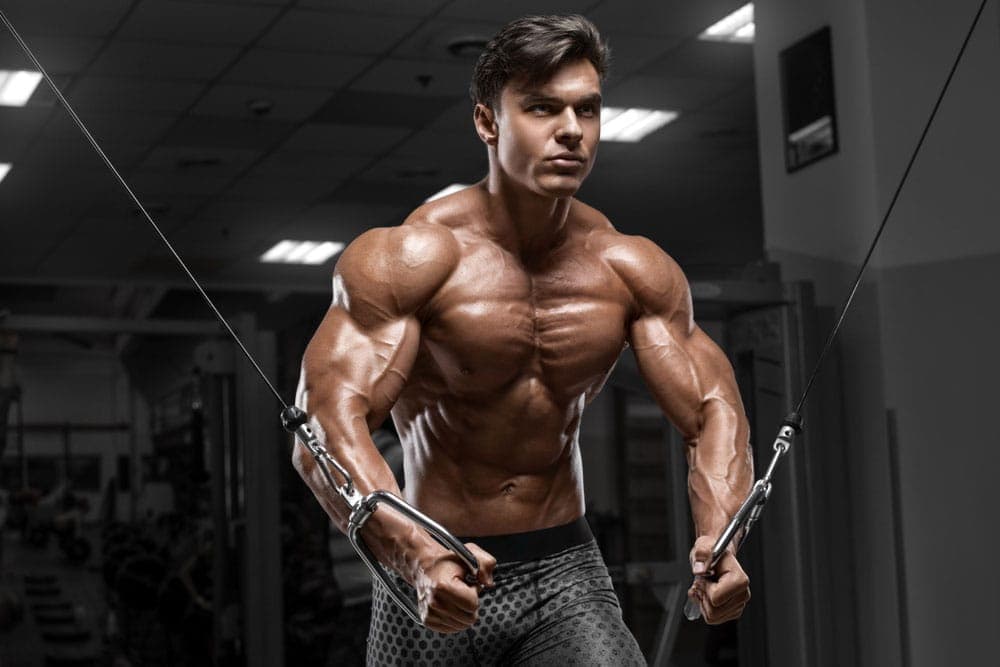5 Best Inner Chest Exercises to Sculpt Your Pecs
Learn how to master the best inner chest exercises to build sculpted and strong pectoral muscles.
Are you looking for a workout to build more strength and definition in your chest? Inner chest exercises are a great place to start.
In this article, we’ll peruse an overview of how inner chest exercises work differently than outer chest exercises.
We’ll get to know the pectoral muscle (chest) anatomy, including all four major muscles that you use for most exercises and how they operate.
Next, we’ll see some of the benefits of targeted inner chest training and find out how both women and men can benefit from it. Finally, we’ll give you 5 moves to tone and train your chest.
Without further ado, here are the best inner chest exercises to build sculpted pectorals.
What are the chest muscles?

The main muscles of your chest (pectoral muscles) are your pectoralis major and pectoralis minor. The pectoralis major helps you flex and move your arms. The pectoralis minor helps you to draw your shoulder blades forward and stabilize your shoulders and chest.
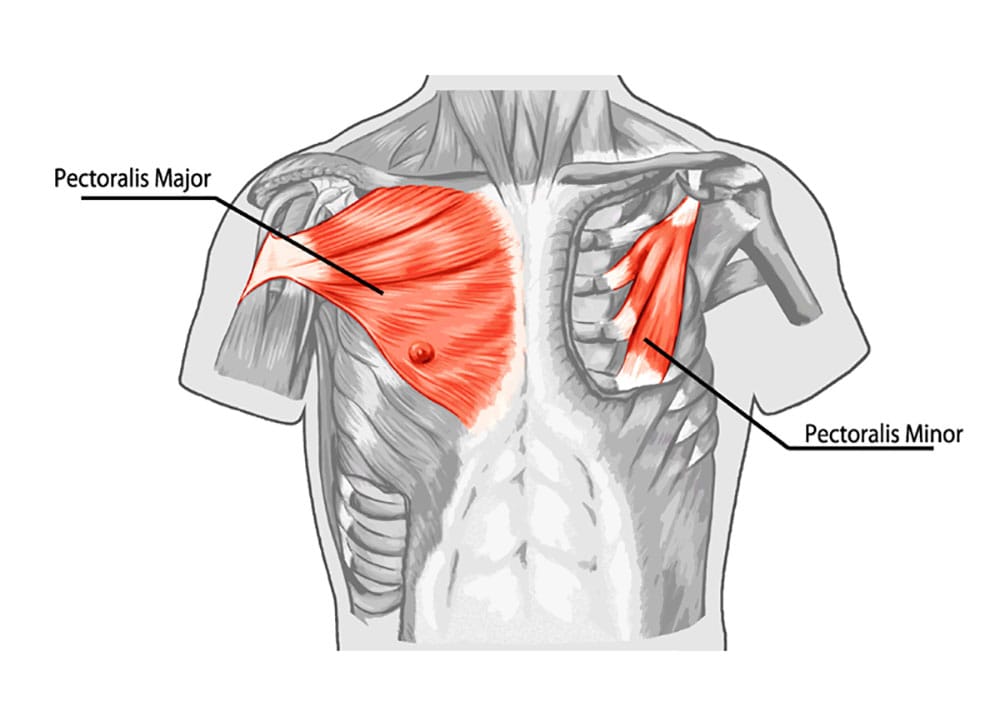
There are two other significant muscles in your chest: serratus anterior and subclavius.
The subclavius helps you keep your clavicles (collarbones) stable while your arms and shoulders move. The serratus helps you to lift your ribcage and breathe, while also helping your shoulder blades to move.
You can find more information about chest muscle structure and function here: Anatomy, Shoulder and Upper Limb, Pectoral Muscles.
Why should I train my inner chest?
Adduction Training
Inner chest exercises help you focus on the adduction of your arms.
This means to move your arms in toward the midline of your body as opposed to abduction. That means sending your arms outward.
Good capacity for adduction will help your with many pressing exercises, like bench presses or the military press and shoulder press.
If you’re investigating different potential fitness goals for the year and have “learn how to bench more” on the agenda, training your inner chest can be a major power generator.
Chest Muscle Definition
If you’re focused on more aesthetic workouts, we have good news for you! Inner chest exercises are some of the best moves you can use to develop a better-looking chest.
If you have small pecs, a chest shape that you don’t like or a gap between your chest muscles, building up your inner chest can give your pectoral muscles a more filled-out look.
Do your chest muscles look a little weak in general? It could be genetic. Here are a few articles on genes and how they impact the look and function of your muscles.
Should women do chest workouts?
Women often neglect training the chest muscles, in favor of lower body and shoulder workouts.
This is because, in terms of aesthetics, a solid chest is known as part of the male phenotype. Chest training also doesn’t increase bust size, but increasing the amount of muscle you hold in your chest can make your chest look fuller, if this is an aesthetic goal.
On the health front, it’s beneficial for both men and women to incorporate chest exercises into their training.
That said, let’s break down 5 simple exercises you can do to target the inner chest muscles.
Best Inner Chest Exercises
Plate Press
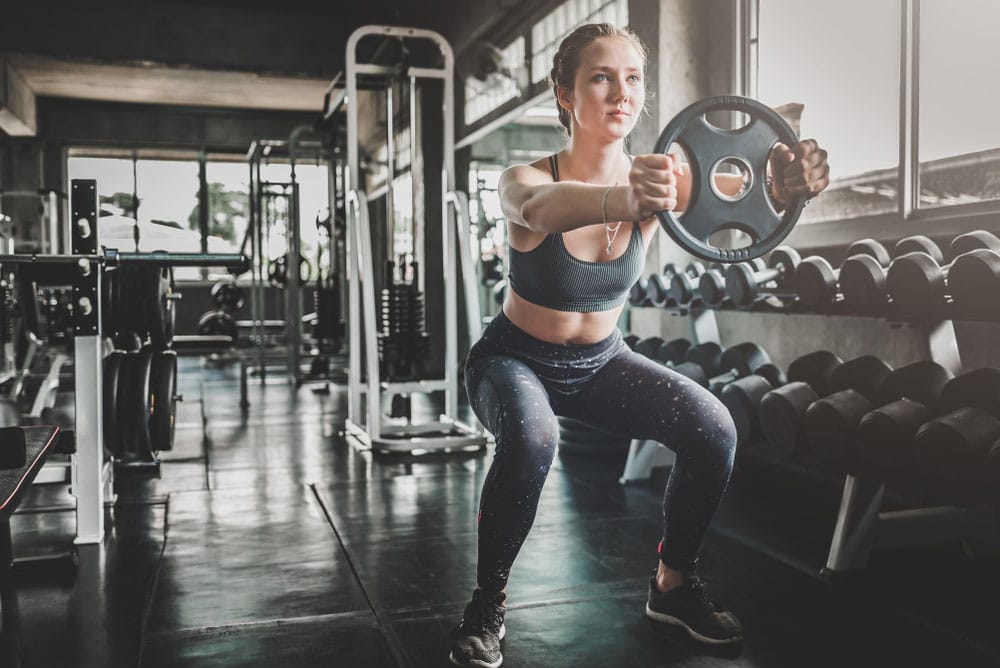
The plate press is a simple inner chest exercise that also hits your arms and core muscles.
- Set-Up: Stand with your feet shoulder-width apart and keep a small bend in your knees. Pick up a weight plate and hold it in front of your chest keeping your elbows bent and out to the sides.
- Press: Push the weight directly out in front of you, straightening your arms. Make sure the weight doesn’t drop down below chest level as you press.
- Reverse: Slowly and with control, bring your plate back in toward your chest.
- Reps: Repeat for as many reps as you need. We recommend at least 3 sets of 8-10 presses.
Dumbbell Pullover

- Set-Up: Lie on a flat weight bench. Plant both feet in a comfortable position on the ground. Wrap your thumbs and forefingers around the head of a medium-heavy dumbbell. Lift your arms up over your chest so the free side of the dumbbell trails down toward your head.
- Pullover: Engage your shoulder blades to keep you stable. Drop your arms down and back behind your head, but do not let your hands drop past your bench to keep the exercise focused on your chest.
- Reverse: Contract the chest muscles and pull your dumbbell back up over your body to the starting position.
- Reps: For strength, try 3-4 sets of 4-8 reps. To train for hypertrophy (muscle growth), aim for 3 sets of 8-12 reps.
Cable Crossover
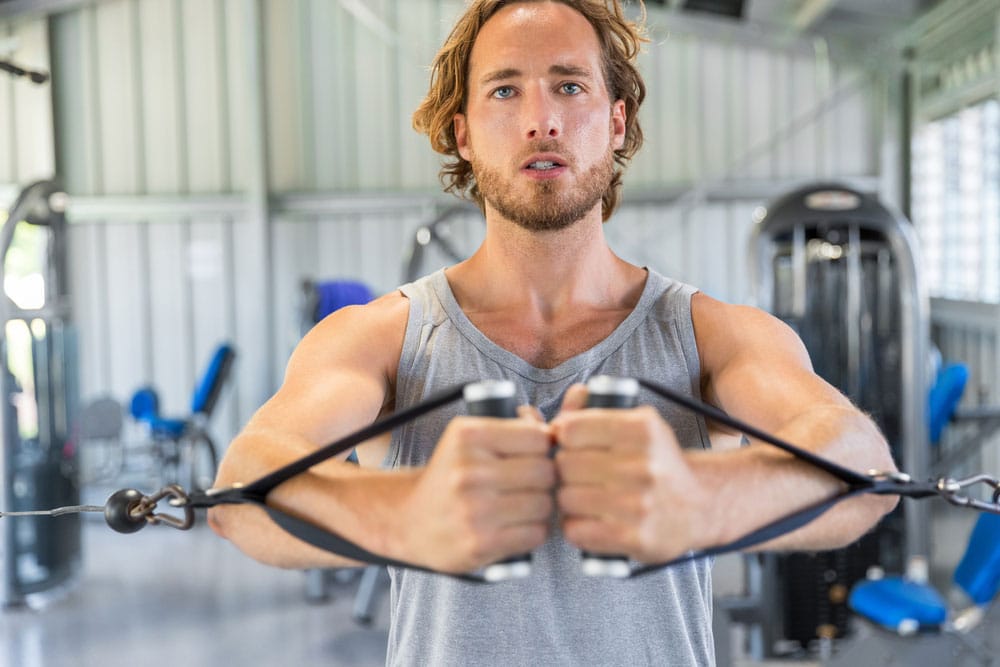
For a cable crossover, you’ll need a weight pulley station with access to two pulleys. Find a simple handle that will fit in one hand (you’ll need one for each hand).
To start:
- Set-Up: Adjust the weight stacks on your pulley system to a comfortable weight that you can pull. Make sure the pulleys are set at an appropriate height. For most people, this should be around your shoulders.
- Grip and Body Position: Grab a handle in each hand. Step away from the pulley machine with one foot to take a split stance. Keep your arms slightly behind your body for a proper starting position and tilt your body forward a few degrees.
- Crossover: Draw your elbows toward the midline of your body. They should be mostly straight with only a slight bend. Bring them in until your hands cross over one another in the middle of the movement.
- Reverse: Resist your weight and bring your arms back out to the sides to return to the starting position.
- Reps: Try this move out for 3-4 sets of 8-12 reps. For a more endurance-focused workout, increase the rep range up to 15 and use a lighter weight.
Pec Deck
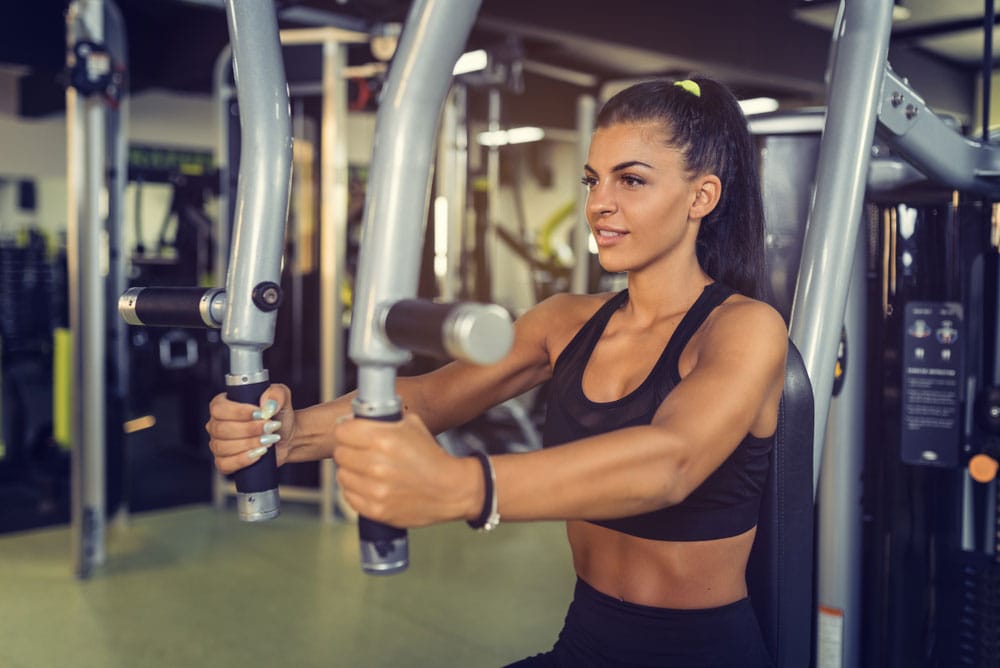
- Set-Up: Select the correct weight for your pec deck machine. Adjust the height of your chair and make sure the arm pads and handles are comfortably positioned. This is your starting position.
- Action: Engaging your chest muscles, exhale and pull your arms together so your hands come as close together as possible.
- Reverse: Slowly reverse your motion, bringing your arms back to the starting position.
- Reps: Continue for as many reps as you need. For most people, 3-4 sets of 10 is a good beginning.
Narrow Grip Push-Up
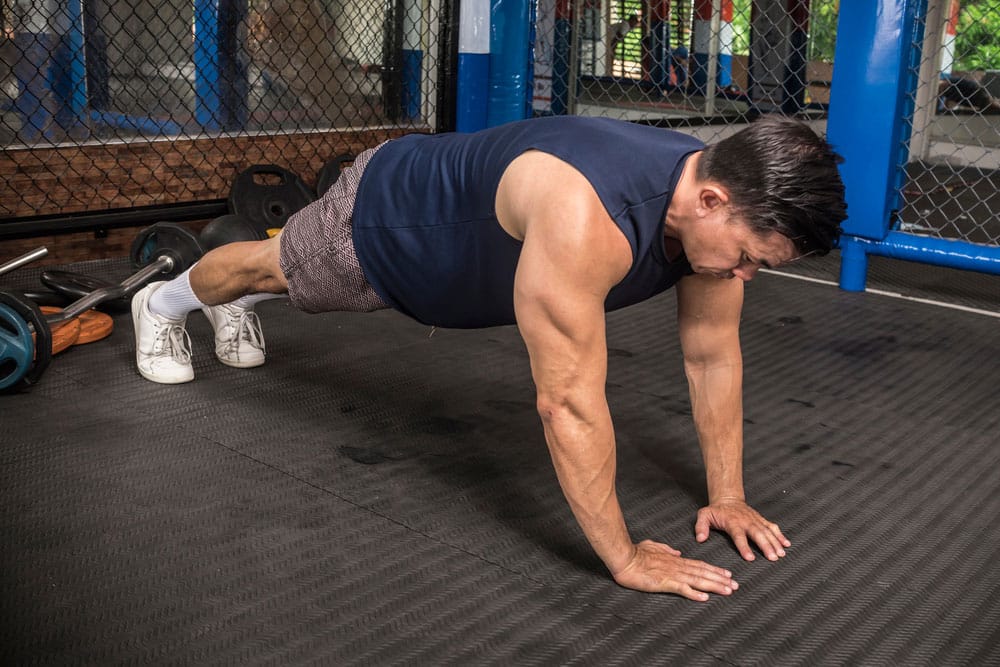
- Set-Up: Start in a plank position with your hands slightly narrower than shoulder-width apart. Your body should form a straight line from head to heels, with fully extended arms.
- Push-Up: Bend your elbows and lower your body toward the ground. Be sure to keep the elbows pointing backwards as you do this. This will help you prevent shoulder injuries. Make sure to hold your body straight. Don’t let your hips sag below the rest of your body or stick your butt up in the air. Doing either takes away from your core engagement. Lower yourself until your chest is just above the ground. Here, your elbows should be at 90 degrees.
- Reverse: Push through the palms of your hands to extend your arms and bring your body back to the starting position using your strength. Keep your body straight throughout the movement.
- Reps: Repeat for as many reps as you need. Try to do at least 3 sets of 10 reps.
Pro-Tip: If you find a full-form push-up too challenging or are unused to working with a narrow grip, try this move on your knees.
Why does my chest have a gap?
Having a gap between the pectoralis major muscles can create a chest gap.
It’s relatively common and normal to have a gap. This is because the muscle bellies of your pecs don’t cover the sternum, which is the bone in the middle of your chest.
Your genes determine how wide or narrow a chest gap you have or if you have one at all.
A chest gap or divet can also be a symptom of a medical condition like pectus excavatum. This is an abnormality where your breastbone sinks into your chest, giving the appearance of a hole or indent.

Studies of pectus excavatum in humans show that mild pectus excavatum does not bother most people, but in severe cases, the chest indent can put pressure on your heart and lungs.
Big picture
Hopefully, you now feel inspired to venture on and train up your inner chest muscles.
With benefits like aesthetics and more functional strength for big chest-powered moves like the bench press, focusing on your inner chest muscles is a fantastic way to prioritize style and function in your lifts.
After these inner chest exercises, remember to take the time to cool down and stretch.
Try a chest stretch like this:

Simply grab or hook one elbow around a doorframe, play structure, or any other upright apparatus that feels comfortable.
Lean into it and feel the stretch through your shoulder. Try to stretch for at least 20 seconds on each side of your chest.
To recharge after a workout, eat a protein-rich snack or meal within one to two hours after you exercise. This will help you satiate your hunger and maximize muscle-building capacity after you work your inner chest.
Track your progress every step of the way as you strengthen your inner chest. The Flex App progresses as you do with plate tracking capabilities and auto progression.
References
Baig MA, Bordoni B. Anatomy, Shoulder and Upper Limb, Pectoral Muscles. [Updated 2023 Aug 28]. In: StatPearls [Internet]. Treasure Island (FL): StatPearls Publishing; 2024 Jan-. Available from: https://www.ncbi.nlm.nih.gov/books/NBK545241/
David V. L. (2022). Current Concepts in the Etiology and Pathogenesis of Pectus Excavatum in Humans-A Systematic Review. Journal of clinical medicine, 11(5), 1241. https://doi.org/10.3390/jcm11051241
Krzysztofik, M., Wilk, M., Wojdała, G., & Gołaś, A. (2019). Maximizing Muscle Hypertrophy: A Systematic Review of Advanced Resistance Training Techniques and Methods. International journal of environmental research and public health, 16(24), 4897. https://doi.org/10.3390/ijerph16244897
Related articles


Get fit with Flex
Build muscle & lose weight fast for free.
Available on iPhone + Apple Watch
